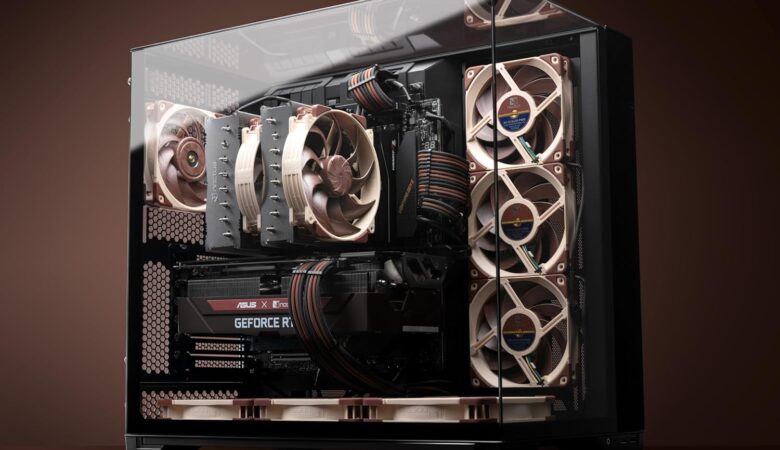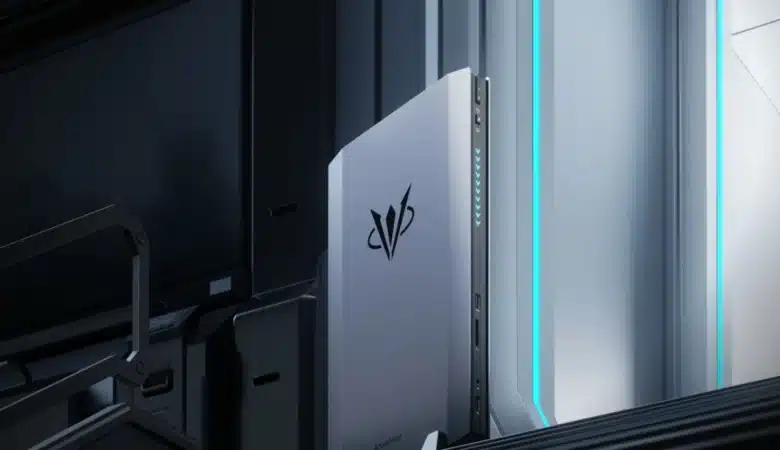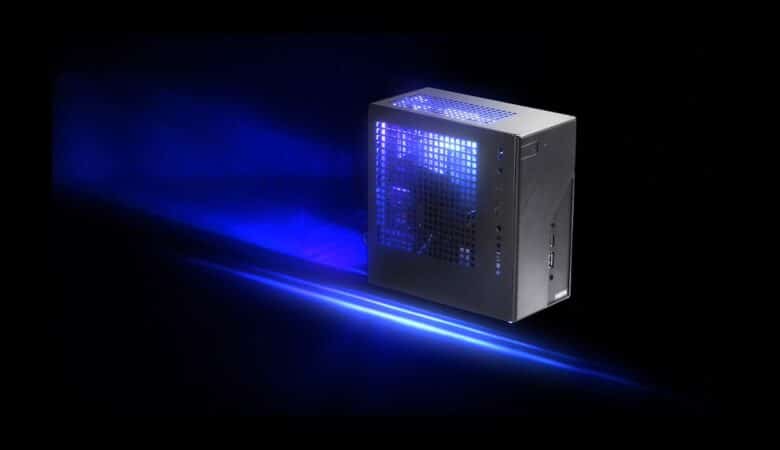It’s all too easy to procrastinate when it comes to selecting the ideal PC case for your next build or to leave the choice until the very end of the part selection process. When designing a PC, you may want to prioritize selecting the finest gaming CPU and graphics card for your demands and budget. You’ll subsequently want to select the greatest motherboard and maybe some storage devices for your system. However, many builders disregard the case, viewing it only as a container for your components.
However, nothing could be farther from the truth. Choosing the finest PC cases for you is critical, as it undoubtedly defines the identity of your computer, influencing not just its appearance but also the components that fit inside, the noise level in your room, and the cooling capacity of your rig.
We’ve compiled a list of the finest PC cases below. As long as the pieces you want to use fit well and you like the appearance, one of these cases should keep you pleased for several years.
The Best PC Cases
Compact Fractal Design Meshify 2 PC Cases
Interior design and cable management are considered.
Three high-quality fans are included.
Expensive.
The Meshify 2 Compact from Fractal Design provides a fantastic foundation for basic ATX gaming systems, as well as a chassis that will survive the test of time. It makes no attempt to be quirky, preferring to provide the user with a nice chassis that will look excellent for years to come — a chassis with which you can grow up. This is one of the best airflow pc cases in the market.
And, while the materials’ quality may be a little lacking, this is a case where you pay for the excellent design, not just in terms of looks, but also in terms of functionality, it has plenty of cable management space, is logically laid out with easy-to-access filters, and is a breeze to use and maintain as a daily driver.
The case’s primary disadvantage is its relatively high price and absence of RGB lighting, but we feel it’s worth it for the case’s well-thought-out functional design.
Lian Li O11 Air Mini PC Cases
Increased cooling capacity and three PWM fans.
Supports ATX motherboards and power supplies.
No longer as focused on ITX.
In recent years, Lian Li’s PC-O11 Dynamic has been a go-to PC case for attractive builds, but its days may be short. The design of the O11D Mini PC case was influenced by it, but it had a few flaws. However, the O11 Air Mini now offers an excellent option.
At $110, you get a lot for your money with this case, which has three PWM fans, a glass panel, a gorgeous appearance, enough IO, an innovative interior design, and complete ATX compatibility.
Although the chassis has an odd side-by-side chambered design, it is simple to build and performs well by current standards. With this many features, such great aesthetics, and such a low price, it’s an easy choice in our list.
900 Dark Base Pro PC Cases
Extremely modular.
Charge wirelessly through Qi.
Support for extensive cooling.
Unusual position for the power supply.
On the expensive side.
Initially noted for its whisper-quiet power supply and fans, keep a low profile! entered the case market with a bang and has performed admirably in the short time since its initial case introduction in 2014. Due to its sleek design and enthusiast-friendly interior, one of its more recent cases, the Dark Base Pro 900, remains one of the highly recommended PC cases.
The Dark Base Pro 900 is sufficiently spacious to accommodate even the largest motherboards and radiators up to 420mm in diameter. Additionally, the case is completely flexible, with an inverted motherboard configuration option and other handy features like wireless Qi charging and preinstalled LED illumination.
Mesh Cooler Master H500P
Excellent airflow.
Magnificent RGB lights.
Not quite as large as other complete skyscrapers.
Cooler Master is quite well-known for, well, cooling stuff – as the Cooler Master H500P Mesh demonstrates. This stunning RGB-enhanced glass pc case provides enough airflow, even fitting up to 360mm radiators on the top and front for when you’re ready to take your cooling to the next level. Add to that the RGB lighting and tempered glass side panel is also the best airflow pc case, and once you acquire this glass pc case you have the makings of a stunning case.
Eclipse P360A by Phanteks
State-of-the-art thermal performance.
The case is ideal for basic ATX systems.
There is no true input filtering.
Phanteks’ P360A retails for around $66, which is a steal considering its feature set. While it may not wow you with its high-quality materials or extremely quiet, it provides all the basics for modest, budget-conscious ATX gaming systems while still adding a splash of personality.
Two 120mm addressable-RGB fans are hidden below the mesh front panel, providing the chassis with a class-leading thermal performance at completely acceptable noise levels. This is a case that is more than capable of handling today’s high-power GPUs, and the top-mounted 240mm radiator can be utilized in conjunction with an AIO to keep your CPU cool as well.
Additionally, Phanteks includes an addressable RGB strip down the chassis’s side, as well as an amazing software-free RGB controller, resulting in a highly comprehensive and simple-to-use ‘just throw parts at it’ kit.
Azer Tomahawk PC Chassis
A sophisticated and modest design.
Build quality comparable to that of a tank.
Chroma ecosystem by Razer.
It’s a bit costly.
The new Razer Tomahawk ATX chassis brings Razer’s subtle design aesthetic to PC cases. It’s a name that should be recognizable to the majority of PC gamers, and while the business is best known as a peripheral producer, it is also well-known in the premium laptop market, where it now occupies the top place in our guide to the best gaming laptops. Smartphones and even financial services are included in the company’s offering.
Case production is a natural progression, and while the Tomahawk is not the first Razer case, it may be the one that establishes Razer as a premium case producer. While brand awareness is not an issue, a fantastic product like this is required to win hearts and minds.
Razer has definitely chosen a low-key aesthetic. The overall design of this razer PC case is nearly entirely devoid of features, with the Razer emblem serving as the lone accent on an otherwise black box. The RGB implementation, not the case itself, is the focal point of this razer PC case.
Reasons For Purchasing PC Cases
There are a variety of reasons why PC cases are required. One is to protect, which is self-evident given its prevalence. Additional justifications include the following: Dust, animals, toys, and liquids, to name a few. All of these factors might cause harm to the machine’s inner components. It is critical to have a sturdy shell for your PC’s casing. It encloses all components and isolates them from the surrounding environment.
Another excellent reason to use PC cases is to keep the environment cool. A big advantage of utilizing a computer casing is that proper ventilation over the computer components is ensured. While the cabinet contains several vents to allow some of the fan air to escape, the majority of it may be used to cool the hardware, which would otherwise get extremely hot and possibly overheat to the point of failure.
Keeping noisy computer components, like fans, in a closed area within the cabinet is one technique to minimize their noise. Additionally, the PC case’s composition is critical. The many components can be compressed together and made effortlessly convenient for the user by being contained in a cabinet. For instance, the USB ports and power button are easily accessible, and you have the option of opening the disc drive at any moment.
The Top Advantages of Having PC Cases
Regulatory Approval
Several decades ago, security was a priority. If you didn’t want your servers to be tampered with, you bolted them down. However, there are now the government and corporate requirements that require physical equipment protection unconditionally, ranging from HIPAA to PCI-DSS to SOX.
Whether you are processing credit card data, patient records, or corporate financial data, you risk severe fines if your system is not secure. Secure access slots, including latching doors and sideway panels, are made simple with well-built computer case enclosures. Additionally, security features such as combination locks, varying access levels, and remote intrusion monitoring are available.
Requirements of the System
If you cannot keep your system cool, it will ultimately shut down, hence cooling is a system necessity. However, do not overlook rack management accessories. If you have tangled piles of wires blocking your system, the airflow will be cut off.
Cable management also decreases human error, which is one of the primary causes of downtime. Additionally, computer cases should allow for tool-free installation of a variety of cable management. Be it horizontal or vertical cable managers, internal or exterior cable managers, or high-density cable managers that enable you to efficiently arrange vast volumes of network patch cables.
Configurability
When you create anything repeatedly, you begin to recognize and appreciate whether a product has characteristics that make repetitive activities less dreary. Keeping this in mind, a PC case should always be designed with the IT person in mind.
There should be innovative features such as tool-free installation of cable management and PDUs, as well as rail depth indexing for simple viewing. Additionally, it should incorporate modular side panels. All of this will only serve to speed up and smooth out each process. This is advantageous when constructing a room full of cabinets, each one crammed with equipment.
Cooling Is the Primary Goal
When you cram a computer case with a variety of different sorts of equipment, you also pack it with a lot of heat. Enclosures for cabinets should be designed to accommodate the heat load generated by high-density installations. Perforated apertures enable substantial front-to-rear airflow, exceeding server manufacturer requirements and promoting hot-aisle/cold-aisle setups for increased cooling effectiveness.
According to different studies conducted by TDI Data Centers, hot-aisle/cold-aisle configurations can save energy consumption by up to 20%. Typically, this requires at least two rows of cases. Nonetheless, you may get the same benefit in a smaller space by merging thermal ducts, which should be a convenient addition. Thermal duct kits are available to direct warm air directly into the HVAC/CRAC return air stream. The return air duct’s undesired pressure pulls heat from the enclosure without the need of additional power.
Suggestions for Purchasing PC Cases
Determine whatever components you have/want initially. Prior to focusing on aesthetics, you’ll want to choose the motherboard, graphics card, and cooler you’ll be utilizing, as well as the number of discs you’ll be installing. This will determine the magnitude of the cases that will be considered.
Cooling is critical, even more so in cheap PC cases and small PC cases. Airflow is critical when it comes to selecting the ideal PC case, even more so when it comes to high-end components in small areas. Before you buy, check cooler reviews for the cooling test results, and keep in mind that cases with glass fronts and tops hinder airflow may require additional fans.
Choose a chassis that appeals to you visually. Your preferred case is likely to spend a significant amount of time in your peripheral vision. Don’t forget to verify the airflow and fit of your components. However, following that, locate something visually appealing to you. Take the time to select a case that visually appeals to you.
FAQs
Is it critical to select PC cases?
Whether you use your computer as the focal point of your home office or just tuck it under your desk, choosing the correct PC case is critical. At the very least, choose a PC case that is the appropriate size for your needs and accommodates all of your hardware and USB devices. You may choose custom PC cases, small pc cases or even cheap pc cases according to your budget.
Does the casing have an effect on the performance of the computer?
PC cases that are less expensive have inadequate cable routing and cooling. It is entirely possible for performance difficulties to occur if your system is not receiving or expelling enough air.






